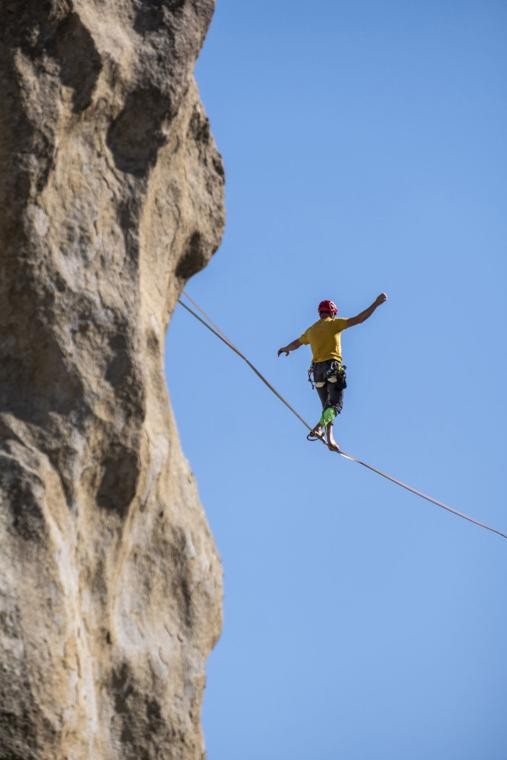ALMO — Highlining has been temporarily prohibited as of Aug. 28 at City of Rocks National Reserve and Castle Rocks State Park.
“We had two people do it (highlining), one in Castle Rocks and one in City of Rocks,” City of Rocks National Reserve and Castle Rocks State Park Superintendent Wallace Keck said. “We’re saying, ‘Wait a minute, let’s get ahead of this.’”
One of the two highlining incidents occurred Aug. 16 during the seventh annual Idaho Mountain Festival at the park and reserve.
Highlining is similar to slacklining, where individuals stretch nylon webbing (effectively a strong rope, sometimes similar to a tow strap) between two anchor points, then walk across the suspended line.
Slackliners typically perform their balancing acts just a few feet above the ground, while highliners set their lines dozens or hundreds of feet in the air. Most highliners wear harnesses to catch them if they fall.
Keck said that National Park Service policy charges him with continually monitoring and examining all park and preserve uses to ensure that the lands do not see unanticipated impacts.
Right now, Keck doesn’t know how highlining could affect the park. After analyzing potential effects, the sport could be allowed in certain areas, and in compliance with a newly established set of rules.
Ryan Robinson is a professional highliner, who participated in the Idaho Mountain Festival after studying the park regulations thoroughly. He added that when he established his highline at Castle Rocks, he did not do so as a member of the Black Diamond athlete team.
Robinson said that highliners and rock climbers have similar codes of ethics — most highliners are also climbers — and are conscientious stewards of public lands. He also noted that he only used existing trails when he was setting up his highline and did not damage any of the park’s rock structures when securing his ropes. No bolts were used to anchor the highline.
Keck made clear that there no rules prohibiting highlining were in place at the time of the festival. But there are potential concerns with how the sport could impact the park. For instance, there has been an increase in bouldering at City of Rocks and Castle Rocks in recent years, which Keck says has had significant effects.
There are a number of reasons to study the impacts of highlining before allowing it. For example, Keck said that one of the highliners might have inadvertently committed a federal crime by anchoring a line on Bureau of Land Management land. Climbing is permitted at Castle Rocks, but it is not permitted on BLM land within Castle Rocks. Keck also expressed concerns about highlining’s impact on park and preserve viewsheds.
Additionally, even if highlining has been a rarity at City of Rocks and Castle Rocks in the past, there’s a chance that the most recent highlining instances could encourage copycats.
“Other people were going to want to reproduce what they saw,” Keck said.
There’s a real chance that the ban will only be temporary. The issue will be discussed with park and preserve stakeholders, and guidelines could be established by January.
“If it’s acceptable to the park’s mission and purpose, then there’s no reason why we wouldn’t find a place for it somewhere,” Keck said.
Robinson said he appreciates the care and attention being paid to Castle Rocks and City of Rocks, but also mentioned the ban might have been unnecessary.
“Just because something is new or unknown doesn’t mean it should be illegal,” he said. “We are lovers of this place and this planet. Our sport is inspiring and gets people outside to enjoy nature while learning the art of balance.”
Keck reiterated that as superintendent, he cannot allow a sport until he knows its real impacts.
“Right now it’s a free for all,” he said. “If I didn’t implement a stop order, you could literally do whatever you wanted. That’s not how anything is managed in the park. Even climbing has rules.”



